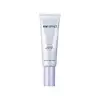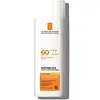Pony Effect Prime Protect Sun Base SPF 50+ Versus La Roche-Posay La Roche Posay Anthelios Ultra Light Face Sunscreen-SPF 60
What's inside
What's inside
 Key Ingredients
Key Ingredients

 Benefits
Benefits

 Concerns
Concerns

 Ingredients Side-by-side
Ingredients Side-by-side

Water
Skin ConditioningCyclopentasiloxane
EmollientEthylhexyl Methoxycinnamate
UV AbsorberButylene Glycol
HumectantZinc Oxide
Cosmetic ColorantEthylhexyl Salicylate
UV AbsorberButyloctyl Salicylate
Skin ConditioningCaprylyl Methicone
Skin ConditioningLauryl PEG-8 Dimethicone
CI 77891
Cosmetic ColorantHydrogenated Polydecene
EmollientIsoamyl Laurate
EmollientIsododecane
EmollientNiacinamide
SmoothingDisteardimonium Hectorite
StabilisingMica
Cosmetic ColorantTrimethylsiloxysilicate
Emollient1,2-Hexanediol
Skin ConditioningPEG-10 Dimethicone
Skin ConditioningPolymethylsilsesquioxane
Echium Plantagineum Seed Oil
Skin ConditioningHelianthus Annuus Seed Oil Unsaponifiables
EmollientCardiospermum Halicacabum Flower/Leaf/Vine Extract
Skin ConditioningViola Mandshurica Flower Extract
AntioxidantMagnesium Sulfate
Glycerin
HumectantTribehenin
EmollientAluminum Hydroxide
EmollientStearic Acid
CleansingVinyl Dimethicone/Methicone Silsesquioxane Crosspolymer
Glyceryl Caprylate
EmollientCaprylic/Capric Triglyceride
MaskingDimethicone
EmollientGlyceryl Tribehenate/Isostearate/Eicosandioate
EmollientHydrogenated Lecithin
EmulsifyingTriethoxycaprylylsilane
Adenosine
Skin ConditioningTrisodium Ethylenediamine Disuccinate
Ceramide NP
Skin ConditioningOctyldodecanol
EmollientTocopherol
AntioxidantSodium Stearoyl Glutamate
CleansingParfum
MaskingBenzyl Salicylate
PerfumingHexyl Cinnamal
PerfumingAlpha-Isomethyl Ionone
PerfumingLinalool
PerfumingCI 77007
Cosmetic ColorantWater, Cyclopentasiloxane, Ethylhexyl Methoxycinnamate, Butylene Glycol, Zinc Oxide, Ethylhexyl Salicylate, Butyloctyl Salicylate, Caprylyl Methicone, Lauryl PEG-8 Dimethicone, CI 77891, Hydrogenated Polydecene, Isoamyl Laurate, Isododecane, Niacinamide, Disteardimonium Hectorite, Mica, Trimethylsiloxysilicate, 1,2-Hexanediol, PEG-10 Dimethicone, Polymethylsilsesquioxane, Echium Plantagineum Seed Oil, Helianthus Annuus Seed Oil Unsaponifiables, Cardiospermum Halicacabum Flower/Leaf/Vine Extract, Viola Mandshurica Flower Extract, Magnesium Sulfate, Glycerin, Tribehenin, Aluminum Hydroxide, Stearic Acid, Vinyl Dimethicone/Methicone Silsesquioxane Crosspolymer, Glyceryl Caprylate, Caprylic/Capric Triglyceride, Dimethicone, Glyceryl Tribehenate/Isostearate/Eicosandioate, Hydrogenated Lecithin, Triethoxycaprylylsilane, Adenosine, Trisodium Ethylenediamine Disuccinate, Ceramide NP, Octyldodecanol, Tocopherol, Sodium Stearoyl Glutamate, Parfum, Benzyl Salicylate, Hexyl Cinnamal, Alpha-Isomethyl Ionone, Linalool, CI 77007
Butyl Methoxydibenzoylmethane 3%
UV AbsorberHomosalate 10%
Skin ConditioningEthylhexyl Salicylate 5%
UV AbsorberOctocrylene 7%
UV AbsorberWater
Skin ConditioningCyclopentasiloxane
EmollientAlcohol Denat.
AntimicrobialSilica
AbrasiveDicaprylyl Ether
EmollientStyrene/Acrylates Copolymer
PEG-30 Dipolyhydroxystearate
EmulsifyingDimethicone
EmollientCyclohexasiloxane
EmollientPolymethylsilsesquioxane
Nylon-12
Dicaprylyl Carbonate
EmollientDiethylhexyl Syringylidenemalonate
Skin ProtectingPhenoxyethanol
PreservativeLauryl PEG/PPG-18/18 Methicone
Skin ConditioningSodium Chloride
MaskingCaprylyl Glycol
EmollientPEG-8 Laurate
EmulsifyingIsostearyl Alcohol
EmollientPoly C10-30 Alkyl Acrylate
Emulsion StabilisingDisteardimonium Hectorite
StabilisingP-Anisic Acid
MaskingCaprylic/Capric Triglyceride
MaskingDisodium EDTA
Cassia Alata Leaf Extract
AstringentPropylene Carbonate
SolventSodium Dodecylbenzenesulfonate
CleansingTocopherol
AntioxidantButyl Methoxydibenzoylmethane 3%, Homosalate 10%, Ethylhexyl Salicylate 5%, Octocrylene 7%, Water, Cyclopentasiloxane, Alcohol Denat., Silica, Dicaprylyl Ether, Styrene/Acrylates Copolymer, PEG-30 Dipolyhydroxystearate, Dimethicone, Cyclohexasiloxane, Polymethylsilsesquioxane, Nylon-12, Dicaprylyl Carbonate, Diethylhexyl Syringylidenemalonate, Phenoxyethanol, Lauryl PEG/PPG-18/18 Methicone, Sodium Chloride, Caprylyl Glycol, PEG-8 Laurate, Isostearyl Alcohol, Poly C10-30 Alkyl Acrylate, Disteardimonium Hectorite, P-Anisic Acid, Caprylic/Capric Triglyceride, Disodium EDTA, Cassia Alata Leaf Extract, Propylene Carbonate, Sodium Dodecylbenzenesulfonate, Tocopherol
 Reviews
Reviews

Ingredients Explained
These ingredients are found in both products.
Ingredients higher up in an ingredient list are typically present in a larger amount.
This ingredient is an emollient, solvent, and texture enhancer. It is considered a skin-softener by helping the skin prevent moisture loss.
It helps thicken a product's formula and makes it easier to spread by dissolving clumping compounds.
Caprylic Triglyceride is made by combining glycerin with coconut oil, forming a clear liquid.
While there is an assumption Caprylic Triglyceride can clog pores due to it being derived from coconut oil, there is no research supporting this.
Learn more about Caprylic/Capric TriglycerideCyclopentasiloxane, or D5, is a silicone used to improve texture of products and trap moisture.
D5 is considered lightweight and volatile. Volatile means it evaporates quickly after application. Once evaporated, D5 leaves a thin barrier that helps keep skin hydrated.
It is also an emollient. Emollients help soften the skin and prevent water loss. Silicones create a silky texture in products. D5 helps other ingredients become more spreadable.
Studies show D5 is safe to use in skincare products. We recommend speaking with a skincare professional if you have concerns.
Learn more about CyclopentasiloxaneDimethicone is a type of synthetic silicone created from natural materials such as quartz.
What it does:
Dimethicone comes in different viscosities:
Depending on the viscosity, dimethicone has different properties.
Ingredients lists don't always show which type is used, so we recommend reaching out to the brand if you have questions about the viscosity.
This ingredient is unlikely to cause irritation because it does not get absorbed into skin. However, people with silicone allergies should be careful about using this ingredient.
Note: Dimethicone may contribute to pilling. This is because it is not oil or water soluble, so pilling may occur when layered with products. When mixed with heavy oils in a formula, the outcome is also quite greasy.
Learn more about DimethiconeDisteardimonium Hectorite comes from the clay mineral named hectorite. It is used to add thickness to a product.
It can also help stabilize a product by helping to disperse other ingredients.
Hectorite is a rare, white clay mineral.
Learn more about Disteardimonium HectoriteEthylhexyl Salicylate is an organic compound used to block UV rays. It primarily absorbs UVB rays but offers a small amount of UVA protection as well.
Commonly found in sunscreens, Ethylhexyl Salicylate is created from salicylic acid and 2-ethylhexanol. You might know salicylic acid as the effective acne fighter ingredient and BHA.
The ethylhexanol in this ingredient is a fatty alcohol and helps hydrate your skin, similar to oils. It is an emollient, which means it traps moisture into the skin.
According to manufacturers, Ethylhexyl Salicylate absorbs UV wavelength of 295-315 nm, with a peak absorption at 307-310 nm. UVA rays are linked to long term skin damage, such as hyperpigmentation. UVB rays emit more energy and are capable of damaging our DNA. UVB rays cause sunburn.
Learn more about Ethylhexyl SalicylatePolymethylsilsesquioxane is a silicone used as a film forming agent.
When applied to the skin, this ingredient creates an invisible film on the surface. This film still allows oxygen to pass through, but prevents moisture from escaping. This can help condition and hydrate the skin. It also leaves a silky feel when applied.
Polymethylsilsesquioxane has not been shown to clog pores. It has been deemed safe to use up to 55%, but most cosmetics use much less.
If you have concerns about using this ingredient, we recommend speaking with a professional.
Learn more about PolymethylsilsesquioxaneTocopherol (also known as Vitamin E) is a common antioxidant used to help protect the skin from free-radicals and strengthen the skin barrier. It's also fat soluble - this means our skin is great at absorbing it.
Vitamin E also helps keep your natural skin lipids healthy. Your lipid skin barrier naturally consists of lipids, ceramides, and fatty acids. Vitamin E offers extra protection for your skin’s lipid barrier, keeping your skin healthy and nourished.
Another benefit is a bit of UV protection. Vitamin E helps reduce the damage caused by UVB rays. (It should not replace your sunscreen). Combining it with Vitamin C can decrease sunburned cells and hyperpigmentation after UV exposure.
You might have noticed Vitamin E + C often paired together. This is because it is great at stabilizing Vitamin C. Using the two together helps increase the effectiveness of both ingredients.
There are often claims that Vitamin E can reduce/prevent scarring, but these claims haven't been confirmed by scientific research.
Learn more about TocopherolWater. It's the most common cosmetic ingredient of all. You'll usually see it at the top of ingredient lists, meaning that it makes up the largest part of the product.
So why is it so popular? Water most often acts as a solvent - this means that it helps dissolve other ingredients into the formulation.
You'll also recognize water as that liquid we all need to stay alive. If you see this, drink a glass of water. Stay hydrated!
Learn more about Water